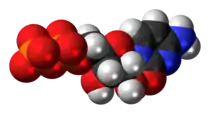 | |
 | |
| Names | |
|---|---|
| IUPAC name
Cytidine 5′-(trihydrogen diphosphate) | |
| Systematic IUPAC name
[(2R,3S,4R,5R)-5-(4-Amino-2-oxopyrimidin-1(2H)-yl)-3,4-dihydroxyoxolan-2-yl]methyl trihydrogen diphosphate | |
| Identifiers | |
| |
3D model (JSmol) |
|
| ChEBI | |
| ChEMBL | |
| ChemSpider | |
| ECHA InfoCard | 100.000.507 |
PubChem CID |
|
| UNII |
|
| |
| |
| Properties | |
| C9H15N3O11P2 | |
| Molar mass | 403.176422 |
Except where otherwise noted, data are given for materials in their standard state (at 25 °C [77 °F], 100 kPa).
Infobox references | |
Cytidine diphosphate, abbreviated CDP, is a nucleoside diphosphate. It is an ester of pyrophosphoric acid with the nucleoside cytidine. CDP consists of the pyrophosphate group, the pentose sugar ribose, and the nucleobase cytosine.
In Bacillus subtilis and Staphylococcus aureus, CDP-activated glycerol and ribitol are necessary to build wall teichoic acid.[1]
See also
References
- ↑ Pereira, Mark P.; Brown, Eric D. (2010-01-01), Holst, Otto; Brennan, Patrick J.; Itzstein, Mark von; Moran, Anthony P. (eds.), "Chapter 19 - Biosynthesis of cell wall teichoic acid polymers", Microbial Glycobiology, San Diego: Academic Press, pp. 337–350, ISBN 978-0-12-374546-0, retrieved 2021-12-08
This article is issued from Wikipedia. The text is licensed under Creative Commons - Attribution - Sharealike. Additional terms may apply for the media files.